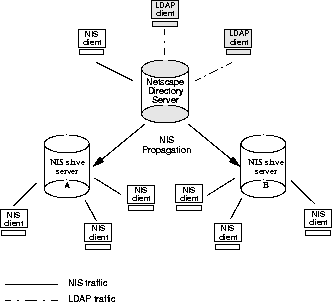If you have a well established NIS environment, the best way to manage the transition without disrupting your naming service is outlined in Figure 1.1, Figure 1.2, and Figure 1.3. The procedure for initializing synchronized NIS/LDAP service is described in Chapter 2, "Initializing and Operating the NIS Service."
Figure 1.1 Pure NIS environment

Figure 1.1 shows a pure NIS environment with NIS requests from clients handled by the closest NIS server on the network. The synchronization of information held on master and slave servers is handled through NIS propagation of tables, using the standard yppush process.
Figure 1.2 Mixed NIS-Netscape Directory Server Environment

Figure 1.2 shows the first stage in the transition to a Netscape Directory Server environment synchronized with NIS. The recommended approach is to replace a master server first so that you can perform write operations on the NIS information in the LDAP directory. You can replace a slave server first, but you will only be able to perform read operations on the NIS information in the LDAP directory.
At this stage, you have the choice between two methods for performing updates to NIS information:
In both cases, it is the standard NIS propagation process, yppush that handles the replication of data to slave servers. The difference is that if you choose the second method for updates, the NIS source files on the master server will no longer be up-to-date.
Note.
Do not use a combination of both methods.
For more information on performing updates to NIS information, refer to "Updating NIS Maps" .
Figure 1.3 Netscape Directory Server Environment

Figure 1.3 shows an environment where all standard NIS servers are synchronized with the Netscape Directory Server. All your servers support both NIS and LDAP clients.
At this stage too, you have the choice of methods for performing updates to NIS information:
You also have the choice of replication methods:
The second method, using LDAP replication is the most efficient.